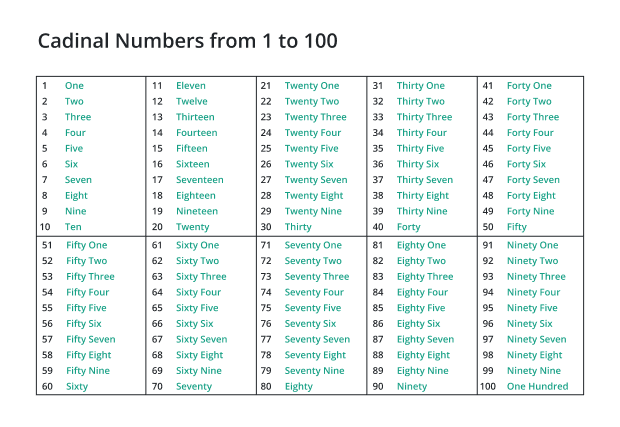To calculate result you have to disable your ad blocker first.
Cardinal Numbers: Analysis with the help of Basics and Uses

Publish Date: 08 Aug, 2023
Table of Content
In mathematics, a cardinal number is used to describe the quantity / numerical value of a group of objects or elements. Numerous more names for them include numbers and counting numbers. Cardinal numerals have a long history dating back thousands of years, evolving throughout many civilizations and cultures.
Mathematicians like Al-Khwarizmi, who produced a fundamental work on arithmetic and algebra in the ninth century, helped spread the Hindu-Arabic number system to the Islamic world and further improved it.
Cardinal numbers evolved to become an essential component of mathematics over time, serving as the foundation for arithmetic, algebra, and many other aspects of the subject.
In this article, we will discuss the basics of cardinal numbers and their uses in daily life and also provide some examples for vision clear about cardinal numbers.
What are Cardinal Numbers?
A quantity /position in a series is indicated by a cardinal number. It is a kind of figure that responds to queries like "How many" and "Which one?" Both spoken and written English frequently include the usage of cardinal numbers, which is a crucial component of human communication.

Representation of Cardinal Numbers:
Cardinal numbers are used in our daily life and we use those numbers without knowing, here are some representations of cardinals:
- Quantity indicator
- Ordinal indicator
- Practical scenarios
As quantity indicator:
The main purpose of cardinal numbers is to express amounts. They provide a precise numerical value to describe the number of objects, people, or things.
For example:
- Each hand of mine has five
- She had two pizza pieces.
As an ordinal indicator:
Cardinal numbers can also function as ordinal indicators, representing the position of an object in a sequence or a series.
For example:
- She won the race, taking first
- The apartment complex's third story is where they reside.
Cardinals Vs Ordinals?
Natural numbers are referred to as cardinals or cardinal numbers. The counting process uses these integers. While ordinal numbers represent the position of an object. For example, 1st, 3rd, etc. are used called ordinals.
The photograph above shows a group of four employees on the job site.
The runners' positions in the running competition are shown in the graphic above. first, next, next, and so forth.
Practical Scenarios of Cardinal Numbers
Cardinal numbers find extensive usage in our daily lives, beyond mere counting. They are employed in a wide range of contexts, such as:
- Age and time
- Measurement and quantities
- Dates and years
- Phone numbers and addresses
- Identifying items
Age and time:
- How old are you? I am twenty-five years old.
- The train will depart at eight o’clock
Measurement and quantities:
- Two cups of flour are necessary for the recipe.
- His speed was around seventy miles per hour.
Dates and years:
- My birthday is on August 14th.
Phone numbers and addresses:
- 555-1234 is the office's telephone number.
- She lives at 123 Main Street.
Identifying items:
- The room number is 307.
List of first ten Cardinal Numbers
Number | Cardinal number |
1 | One |
2 | Two |
3 | Three |
4 | Four |
5 | Five |
6 | Six |
7 | Seven |
8 | Eight |
9 | Nine |
10 | Ten |
List of Cardinal Numbers multiple of 5:
Number | Cardinal number |
5 | Five |
10 | Ten |
15 | Fifteen |
20 | Twenty |
25 | Twenty-five |
30 | Thirty |
35 | Thirty-five |
40 | Forty |
45 | Forty-five |
50 | Fifty |
List of Cardinal Numbers multiple of 100:
Number | Cardinal number |
100 | One hundred |
200 | Two hundred |
300 | Three hundred |
400 | Four hundred |
500 | Five hundred |
600 | Six hundred |
700 | Seven hundred |
800 | Eight hundred |
900 | Nine hundred |
1000 | One thousand |
Examples of Cardinal Numbers
Example 1:
Ali has a list of numbers as shown: 4, 8th,5th, 3, 8th, 1st, 2. Find the cardinal numbers.
Solution:
Step 1: Extract data
4, 8th,5th, 3, 6th, 1st, 2
Step 2: Identify cardinal numbers
Cardinal numbers = 1st, 5th, 6th, 8th
Example 2:
What is the position of the strawberry from the left?
Solution:
The strawberry is located in the second from the left position and the second number is ordinal.
Example 3:
Determine how many vowels are in "NUMBERS" for Asad. Count how many alphabets were used to create this word.
Solution:
- We are aware that the vowels a, e, i, o, and u are employed in the provided word. Since two is the necessary cardinal number, this number is formed using two vowels.
- We find that "Numbers" contains a total of 7 alphabets as we count from N to S. Because seven is a cardinal number, the provided word must be created using a total of seven alphabets.
Conclusion:
In this article, we discussed the basics of cardinal numbers along with what are the methods of representation of cardinal numbers. We also analyzed the use of cardinal numbers in our daily life. We also proved a list of cardinals for better understanding and solved some examples to vision clear about cardinal numbers.

